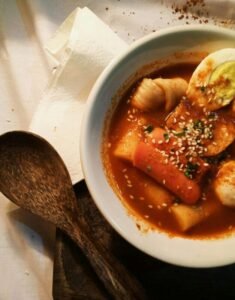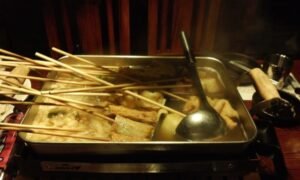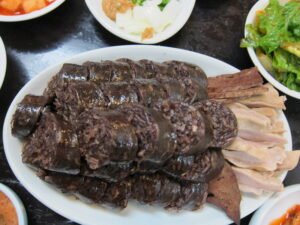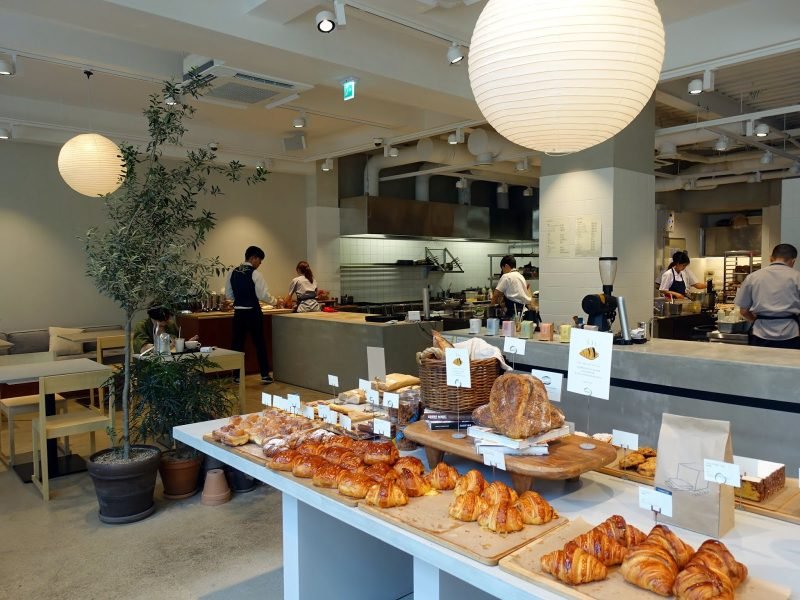Introduction: Korea’s Vibrant Street Food Culture
Korean street food, a dazzling array of colors, flavors, and aromas, is an essential thread in the fabric of Korean culture. It offers a window into the soul of Korea, where tradition meets modernity on the bustling streets of its cities and towns. This culinary landscape is not just about food; it’s a vibrant expression of Korea’s rich history, communal spirit, and innovative zest.
Street food in Korea transcends mere convenience, embedding itself deeply into the daily lives of its people and the nation’s festive celebrations. From early morning markets to late-night snack vendors, these culinary delights are accessible to everyone, providing a quick, delicious, and affordable way to enjoy a meal on the go. Moreover, street food plays a pivotal role during Korean festivals, where special dishes are prepared and savored, marking the occasion with taste and tradition.
The History of Korean Street Food
From Traditional Markets to Modern Scenes
The story of Korean street food is a tale of evolution, tracing back to ancient markets and royal courts. Initially, street food began as a necessity for commoners and travelers, offering simple, hearty meals. Over centuries, these humble beginnings transformed, influenced by Korea’s dynastic changes, wars, and economic developments. Traditional markets, once the heart of Korean communities, have now expanded into vibrant street food scenes that blend the old with the new.
Historical and Cultural Influence
Korean street food has been shaped significantly by historical and cultural events. The Korean War, for example, led to the creation of dishes such as budae jjigae (army base stew), reflecting the country’s resilience and ability to innovate under hardship. Furthermore, Korea’s rapid modernization brought about a fusion of traditional Korean flavors with Western influences, giving rise to new and exciting variations of street food.
The Joseon dynasty’s influence on Korean cuisine cannot be understated, with royal dishes becoming simplified for the masses, thus enriching the variety of street foods available. Additionally, Korea’s agricultural heritage is showcased in the seasonal and regional diversity of street snacks, from sweet red bean buns in winter to spicy, refreshing cucumbers in summer.
Today’s Korean street food scene is a dynamic and ever-evolving tapestry, reflecting the nation’s history, its people’s creativity, and the ongoing dialogue between tradition and modernity. Whether it’s through a steaming cup of tteokbokki or a crispy hotteok, Korean street food offers a delicious journey through time, culture, and community.
Iconic Korean Street Foods
Korean street food is celebrated for its diversity, taste, and accessibility. Here’s a deep dive into some of the most iconic dishes that have captured the hearts of both locals and travelers alike.
1. Tteokbokki (Spicy Rice Cakes)
- Origins and Popularity : Tteokbokki, once a part of Korean royal cuisine, has transformed into a beloved street food staple. Its origins trace back to the Joseon Dynasty, where it was a savory stir-fried dish. Today, it’s known for its spicy, sweet sauce and chewy rice cakes, making it a favorite among people of all ages.
- Variations and Where to Find Them : Beyond the classic spicy version, tteokbokki comes in various forms, including cheese tteokbokki, seafood tteokbokki, and even a non-spicy version with soy sauce. You can find this dish in almost any street food market across Korea, with Seoul’s Sindang-dong Tteokbokki Town being a famous hotspot.
2. Gimbap (Korean Sushi Rolls)
- Description and Ingredients : Gimbap consists of seaweed rolls filled with rice, vegetables, and often meats or fish. Common fillings include spinach, carrot, radish, cucumber, egg, and beef. It’s a versatile and portable dish, making it perfect for on-the-go meals.
- Regional Specialties and Twists : While traditional gimbap remains popular, innovative versions such as cheese gimbap, tuna gimbap, and bulgogi gimbap cater to diverse tastes. Each region in Korea has its own specialty, with variations in ingredients and seasoning.
3. Odeng (Fish Cake Skewers)
- Historical Background : Odeng, borrowed from Japanese cuisine post-World War II, has become a fixture in Korean street food. These fish cakes are typically skewered and simmered in a savory broth.
- Serving Styles and Broth Significance : Often served with a side of broth, odeng is not just delicious but also comforting during Korea’s colder months. The broth, enriched with the flavors of the fish cakes, is free to enjoy and symbolizes warmth and generosity.
4. Hotteok (Sweet Korean Pancakes)
- Introduction to This Sweet Treat : Hotteok is a winter favorite, featuring a dough pancake filled with a sweet mixture, usually consisting of brown sugar, honey, chopped peanuts, and cinnamon.
- Fillings and Seasonal Variations : While the traditional hotteok is sweet, savory versions filled with vegetables or meat have emerged, expanding its appeal. Seasonal ingredients also influence the fillings, offering a delightful taste of Korea’s seasons in each bite.
5. Sundae (Korean Blood Sausage)
- Explanation and Ingredients : Sundae is a type of Korean blood sausage made from cow or pig’s blood, mixed with noodles and various ingredients, then stuffed into intestine casings. It’s a dish with deep historical roots and varies by region, incorporating local flavors and traditions.
- Accompaniments and Best Places to Try : Typically served with salt, seasonings, and sometimes with liver or lungs, sundae can be found in traditional markets and specialized sundae restaurants. Gwangjang Market in Seoul is particularly famous for its sundae, offering an authentic taste of this unique dish.
Each of these iconic street foods provides a taste of Korea’s rich culinary heritage, showcasing the country’s love for flavors, innovation, and communal dining. Whether you’re exploring the bustling streets of Seoul or the quaint alleys of a smaller town, the allure of Korean street food is impossible to resist.
Emerging Trends in Korean Street Food
Korean street food is not just a testament to the country’s rich culinary traditions but also a reflection of its dynamic and evolving food culture. Here are some of the latest trends reshaping the Korean street food scene.
Fusion Dishes and International Influences
The global palate is increasingly influencing Korean street food, leading to the creation of fusion dishes that combine traditional Korean flavors with international cuisines. Examples include kimchi quesadillas, bulgogi tacos, and tteokbokki pizza. These innovative creations cater to a growing demand for diverse and globally inspired tastes, showcasing Korea’s adaptability and creativity in the culinary realm.
The Rise of Health-Conscious and Vegetarian Street Food Options
As health awareness and dietary preferences evolve, Korean street food vendors are expanding their offerings to include more health-conscious and vegetarian options. This includes dishes made with organic ingredients, gluten-free options, and vegetarian or vegan versions of traditional street foods like mandu (dumplings) and bibimbap (mixed rice). This trend reflects a broader shift towards healthier eating habits and inclusivity in dining choices.
Street Food Etiquette and Tips
To fully enjoy the Korean street food experience, it’s helpful to understand some basic etiquette and tips. Here’s how to navigate the vibrant street food markets like a local.
How to Order and Enjoy Street Food Like a Local
- Be Open to Experimenting : Part of the joy of street food is trying new and unfamiliar dishes. Don’t hesitate to sample something you’ve never seen before.
- Use Simple Korean Phrases : Knowing basic phrases like “Igeol juseyo” (이걸 주세요, “Please give me this”) can enhance your ordering experience. Pointing and smiling also go a long way.
- Cash is King : While more vendors are accepting digital payments, cash is still widely used for street food transactions. Keeping small bills on hand makes payments smoother.
Tips for Navigating Street Food Markets
- Visit During Off-Peak Hours : To avoid crowds and enjoy a more relaxed experience, consider visiting street food markets during off-peak hours, typically late morning or early afternoon.
- Follow the Locals : Locals know best. Look for stalls with a queue of Koreans; this is often a sign of quality and authenticity.
- Hygiene Matters : While Korean street food is generally safe, it’s still wise to choose vendors who maintain clean and hygienic preparation areas.
- Sharing is Caring : Many street foods are designed to be shared. Ordering a variety of dishes and sharing with friends or fellow travelers is a great way to enjoy a wider range of tastes.
By keeping these emerging trends and etiquette tips in mind, you can fully immerse yourself in the rich tapestry of Korean street food culture, discovering not just the flavors but also the evolving trends and communal spirit that make it so special.
Must-Visit Street Food Markets in Korea
Korea’s street food markets are bustling epicenters of culture, flavor, and tradition. Here are three must-visit markets, each offering a unique glimpse into Korea’s vibrant street food scene.
1. Gwangjang Market, Seoul
Overview and Must-Try Foods : Established in 1905, Gwangjang Market is one of the oldest and largest traditional markets in Seoul. It’s a haven for food enthusiasts, offering a wide array of Korean street food. Must-try items include bindaetteok (mung bean pancakes), mayak gimbap (mini seaweed rice rolls), and yukhoe (Korean beef tartare). The market’s bustling atmosphere, combined with the rich smells and flavors of authentic Korean cuisine, provides a feast for the senses.
2. Myeongdong Street Food Alley, Seoul
Highlights and Unique Finds : Myeongdong is not just a shopping paradise; it’s also famous for its street food alley, offering everything from classic Korean snacks to inventive fusion foods. Highlights include cheese-stuffed tteokbokki, egg bread (gyeran-ppang), and ice cream in a fish-shaped waffle cone. The vibrant neon lights and the energetic crowds create an exciting backdrop for indulging in these delicious treats.
3. Bupyeong Kkangtong Market, Busan
Seafood Specialties and Local Favorites : Located in the heart of Busan, Bupyeong Kkangtong Market is renowned for its seafood. Here, you can savor fresh sashimi, grilled shellfish, and the famous Busan fish cakes. The market also offers a variety of other street foods, making it a perfect spot to explore the local flavors of Busan. The lively atmosphere and the friendly vendors add to the market’s charm, making it a memorable destination for food lovers.
Conclusion
Korea’s street food scene is a dynamic and delicious journey through the country’s culinary traditions and innovations. From the historical alleys of Gwangjang Market to the bustling streets of Myeongdong and the seafood-rich stalls of Bupyeong Kkangtong Market, each destination offers a unique taste of Korea. As you explore these markets, you’ll not only indulge in mouth-watering dishes but also experience the warmth and hospitality of Korean culture.
Additional Resources
For those eager to dive deeper into Korea’s street food culture, numerous food blogs and apps can guide you to the best eats around the country. Websites like “Seoul Eats” and “ZenKimchi” offer insightful reviews and recommendations, while apps like “Mangoplate” and “Naver Maps” provide up-to-date information on the hottest street food spots and directions on how to get there. These resources can be invaluable companions in your culinary adventures, helping you discover even more flavors and dishes.
Embark on this culinary adventure with an open heart and appetite, and you’ll find that Korean street food is more than just food; it’s a way to connect with the country’s culture, history, and people.









